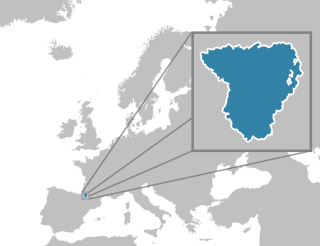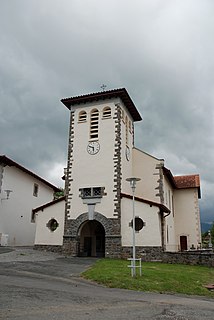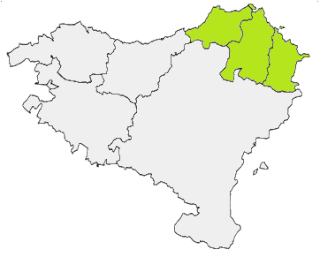
Dominique Joseph Garat was a French Basque writer and in 1792 minister of Justice and in 1793 minister of Interior.

The Béarn is one of the traditional provinces of France, located in the Pyrenees mountains and in the plain at their feet, in southwest France. Along with the three Basque provinces of Soule, Lower Navarre, and Labourd, the Principality of Bidache, as well as small parts of Gascony, it forms in the southwest the current département of Pyrénées-Atlantiques (64). The capitals of Béarn were Beneharnum, Morlaàs, Orthez, and then Pau.

Ainhoa is a commune in the Pyrénées-Atlantiques department in the Nouvelle-Aquitaine region in southwestern France.

Athos-Aspis is a commune in the Pyrénées-Atlantiques department in the Nouvelle-Aquitaine region of south-western France.

Ahetze was a village in the traditional Basque province of Labourd and is now a commune in the Pyrénées-Atlantiques department in the Nouvelle-Aquitaine region in southwestern France. The commune is part of the urban area of Bayonne.

Arbonne is a commune in the Pyrénées-Atlantiques department in the Nouvelle-Aquitaine region of southwestern France.

Ascain is a commune in the Pyrénées-Atlantiques department in the Nouvelle-Aquitaine region of south-western France.

Bassussarry is a commune in the Pyrénées-Atlantiques department in the Nouvelle-Aquitaine region of southwestern France.

Ahaxe-Alciette-Bascassan is a commune in the Pyrénées-Atlantiques department in the Nouvelle-Aquitaine region in southwestern France.

Ainhice-Mongelos is a commune in the Pyrénées-Atlantiques department in the Nouvelle-Aquitaine region in southwestern France.

Aïcirits-Camou-Suhast is a commune in the Pyrénées-Atlantiques department in the Nouvelle-Aquitaine region in southwestern France.

La Bastide-Clairence is a commune in the Pyrénées-Atlantiques department in the Nouvelle-Aquitaine region of south-western France.

Barcus is a commune in the Pyrénées-Atlantiques department in the Nouvelle-Aquitaine region of southwestern France in the former province of Soule.

Arrast-Larrebieu is a commune in the Pyrénées-Atlantiques department in the Nouvelle-Aquitaine region of south-western France.

The French Basque Country, or Northern Basque Country is a region lying on the west of the French department of the Pyrénées-Atlantiques. Since 1 January 2017, it constitutes the Basque Municipal Community presided over by Jean-René Etchegaray.

The former Roman Catholic Diocese of Oloron was a Latin rite bishopric in Pyrénées-Atlantiques department, Aquitaine region of south-west France, from the 6th to the 19th century.

The Diocese of Bayonne, Lescar, and Oloron, commonly Diocese of Bayonne, is a Latin Church ecclesiastical territory or diocese of the Catholic Church in France. It is a suffragan diocese in the ecclesiastical province of the metropolitan Archdiocese of Bordeaux. The diocese comprises the département of Pyrénées-Atlantiques, in the région of Nouvelle-Aquitaine.

Jean-Baptiste-Auguste de Villoutreix was the last Catholic Bishop of Oloron in France.
The end of Basque home rule or foruak/fors, the native institutional and legal system, took place during the French revolutionary period (1789-1795). The final violent dissolution of the semi-autonomous Basque institutional and legal system was coupled with the arrival of French troops to the Basque Country within the War of the Pyrenees and a deliberate terror on the Basque population centred in Labourd.
The Estates of Navarre(French: États de Navarre, États généraux de Navarre, Cortes de Navarre) were created in 1317 under Philip II. The Estates of Lower Navarre(French: États de Basse-Navarre, Cortes de la Basse-Navarre) were first called into session on 28 August 1523 by Henry II after the definitive loss of Upper Navarre,


















